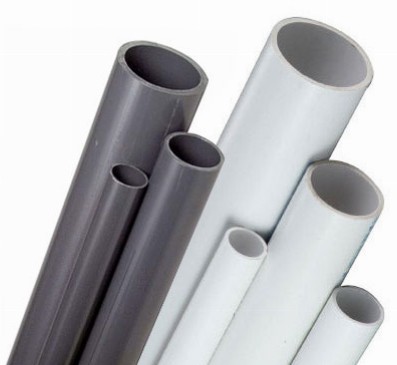Many people don't realize that PVC, or polyvinyl chloride, is a plastic. They also don't realize how many uses it has aside from piping. It is commonly used in imitation leather, shower curtains, window frames, and curtains. When curious people do an online search for "PVC vs Plastic," what they should really be searching for is "PVC and other plastics compared," so that is what I will do.
PVC is an extremely versatile material which is most commonly used for piping because of its inexpensive production and high mechanical strength. In this post, we will outline the major properties of PVC and compare it to some other common plastics. For the highest-quality, least expensive PVC pipe and fittings available, check out our online store!
Polyvinyl Chloride (PVC)
 As a material, PVC has not changed much since 1926. It has high hardness and mechanical strength, meaning it is very strong. It has a low temperature tolerance, breaking down at temperatures over 140 degrees Fahrenheit and melting at temperatures over 160 degrees, unless it is put through an extra chlorination process; this makes it CPVC. As far as its electrical properties, PVC has good insulation, but, because it has polar elements to its composition, it has worse insulation than other plastics, such as polyethylene and polypropylene.
As a material, PVC has not changed much since 1926. It has high hardness and mechanical strength, meaning it is very strong. It has a low temperature tolerance, breaking down at temperatures over 140 degrees Fahrenheit and melting at temperatures over 160 degrees, unless it is put through an extra chlorination process; this makes it CPVC. As far as its electrical properties, PVC has good insulation, but, because it has polar elements to its composition, it has worse insulation than other plastics, such as polyethylene and polypropylene.
PVC is extremely chemical-resistant, able to withstand acids, salts, bases, fats, and alcohols. For this reason, it is often used in sewage piping. It is even resistant to some solvents, such as fuel and paint thinners, but some may damage it; therefore, using PVC to drain or hold solvents isn't recommended. PVC can be produced in a variety of colors, but primarily comes in white, dark gray, or blue-ish clear. In addition to the applications listed in the introduction, PVC is used for home siding and gutters, skiing equipment, medical tubing, and much more.
Polyethylene (PE)
PE is the most common type of plastic, with around 80 million tons of it produced every year. It was industrialized in 1939 and is primarily found in packaging, including plastic bags, films, and bottles. Like all plastics, it comes in many different forms and is very versatile. Unline PVC, PE has low strength, hardness, and rigidity. It makes up for that by having high ductility (the ability to be stretched into wire) and impact strength (the ability to withstand a suddenly applied impact). This flexible and malleable material has a slightly higher temperature rating than PVC, softening at 176 degrees. Different density PE will have different melting points. The higher the density, the higher the melting point.
PE absorbs almost no water, and gas and water vapors have a tough time permeating it. When exposed to sunlight for extended periods, PE can become brittle. It burns with a blue flame and will continue burning if the flame source is removed. PE is a good electrical insulator, but can easily become electrostatically charged when not properly treated. Depending on the thickness, PC can be anywhere from transparent to opaque. Many different forms and compounds exist with polyethylene as the basis, which is why it is called the most common plastic.
Polystyrene (PS)
PS is another widely-used plastic that takes many different forms. First mass-produced in 1931, it is most commonly used in Styrofoam, plastic tableware, disposable cups, disposable plates, and CD cases. PS takes a long time to biodegrade, and is therefore controversial among environmentalists. Its foam form is often found littering shores and waterways, especially in the Pacific Ocean. When properly recycled, it can be used for insulation sheets, clothes hangers, and park benches.
PS has a higher melting point than PVC at around 464 degrees, but will start decomposing at lower temperatures. It is classified as a highly flammable or "easily ignited" material, and is thus prohibited in any exposed building construction uses if the material is not flame-retardant. It must be concealed behind drywall, sheet metal, or concrete.
Polypropylene (PP)
PP was first created in 1951 and is a polymer that is used for a wide range of applications including ropes, carpets, loudspeakers, automobile bumpers and fenders, laboratory equipment, and stationery. It is known to have a slick, or slippery surface that most common glues will not properly adhere to. Most often, PP is joined together with welding processes. This plastic has low density, the lowest of any of the "commodity plastics." Despite this low density, PP is tough and flexible while remaining an economical choice for manufacturers.
Depending on what type of PP it is, the melting point is anywhere from 266 to 340 degrees, and it becomes brittle anywhere below 32 degrees. PP can start degrading when exposed to heat and UV radiation from sunlight, and is therefore often treated to prevent this from happening. This polymer can be made translucent, but is not as easy to make transparent as polystyrene; often it is colored using pigments.
Countless other plastics, polymers, and variation exist, but you should now know what makes each stand out! Further research into these can get pretty scientific, so make sure to have Wikipedia handy. And don't forget visit our online store for all your PVC pipe and fitting needs!
























































